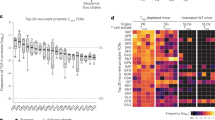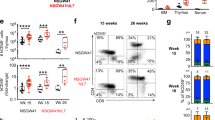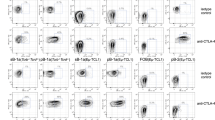Abstract
Two major alternative models, clonal deletion and suppression, have been proposed as possible explanations for immunological tolerance1,2. We have now isolated a functional T suppressor (Ts) cell clone to analyse the role of Ts cells in the induction and maintenance of tolerance. This cloned, long-term cultured Ts cell line (HF1) was derived from CBA/J mice (H–2k) in which low-zone tolerance (LZT)3 had been induced by sub-immunogenic doses of bovine serum albumin (BSA). HF1 cells show BSA-specific suppressor activity in two in vitro suppressor assays. HF1 Ts cells and a factor derived from them suppress imprinted, carrier-specific T helper (Th) cells in an assay measuring IgG antibody production against fluorescein-conjugated BSA (Flu-BSA). Furthermore, they block DNA synthesis in an antigen-specific in vitro T-cell proliferation assay. Their proliferation in the presence of antigen-presenting cells is antigen specific and shows restriction to the I–Ak region of the major histocompatibility complex (MHC). In addition, HF1 Ts cells have a characteristic cytotoxic activity. The data reported suggest that clonal deletion and suppression models are not necessarily mutually exclusive. Clonal deletion could manifest itself by the action of Ts cells.
This is a preview of subscription content, access via your institution
Access options
Subscribe to this journal
Receive 51 print issues and online access
$199.00 per year
only $3.90 per issue
Buy this article
- Purchase on Springer Link
- Instant access to full article PDF
Prices may be subject to local taxes which are calculated during checkout
Similar content being viewed by others
References
Burnet, F. M. The Clonal Selection Theory of Acquired Immunity (Cambridge University Press, 1959).
Gershon, R. K. & Kondo, K. Immunology 21, 903–914 (1971).
Mitchison, N. A. Immunology 15, 509–530 (1968).
Kölsch, E., Stumpf, R. & Weber, G. Transplant Rev. 26, 56–86 (1975).
Stumpf, R., Heuer, J. & Kölsch, E. in Function and Structure of the Immune System (eds Müller-Ruchholtz, W. & Müller-Hermelink, H. K.) 333–338 (Plenum, New York, 1979).
Brüner, K. & Kölsch, E. Cell. Immun. 62, 436–447 (1981).
Heuer, J. & Kölsch, E. Immunogenetics 14, 163–167 (1981).
Wysocki, L. J. & Sato, V. L. Proc. natn. Acad. Sci. U.S.A. 75, 2844–2848 (1978).
Sredni, B., Tse, H. Y. & Schwartz, R. H. Nature 283, 581–583 (1980).
Ricciardi-Castagnoli, P., Doria, G. & Adorini, L. Proc. natn. Acad. Sci. U.S.A. 78, 3804–3808 (1981).
Taniguchi, M. & Miller, J. F. A. P. J. exp. Med. 148, 373–382 (1978).
Pierres, M., Germain, R. N., Dorf, M. E. & Benacerraf, B. Proc. natn. Acad. Sci. U.S.A. 74, 3975–3979 (1977).
Corradin, G., Etlinger, H. M. & Chiller, J. M. J. Immun. 119, 1048–1053 (1977).
Swierkosz, J. E., Marrack, P. & Kappler, J. W. J. exp. Med. 150, 1293–1309 (1979).
Fresno, M., Mc Vay-Boudreau, L., Furthmayer, H. & Cantor, H. J. exp. Med. 153, 1260–1274 (1981).
Bevan, M. J. & Cohn, M. J. Immun. 114, 559–565 (1975).
von Boehmer, H. & Haas, W. Immun. Rev. 54, 27–56 (1981).
Parks, D. E. & Weigle, W. O. Immun. Rev. 43, 217–240 (1979).
Bretscher, P. & Cohn, M. Science 169, 1042–1049 (1970).
Nabholz, M., Engers, H. D., Collavo, D. & North, M. Curr. Topics Microbiol. Immun. 81, 176–187 (1978).
Fresno, M., Nabel, G., McVay-Boudreau, L., Furthmayer, H. & Cantor, H. J. exp. Med. 153, 1246–1259 (1981).
Author information
Authors and Affiliations
Rights and permissions
About this article
Cite this article
Heuer, J., Brüner, K., Opalka, B. et al. A cloned T-cell line from a tolerant mouse represents a novel antigen-specific suppressor cell type. Nature 296, 456–459 (1982). https://doi.org/10.1038/296456a0
Received:
Accepted:
Issue Date:
DOI: https://doi.org/10.1038/296456a0
This article is cited by
-
Effect of murine interferon ?/? on tumor-induced suppressor function
Cancer Immunology Immunotherapy (1994)
-
Suppression of experimentally induced autoimmune encephalomyelitis by cytolytic T–T cell interactions
Nature (1988)
-
Expression of L3T4 molecules on Lyt-2+, class II-restricted antigen-specific T suppressor lymphocytes
Immunogenetics (1986)
-
Tolerance Induction and Maintenance in Primed Lymphocytes
Survey of Immunologic Research (1985)
-
Tolerance: Facts and views — 1983
Survey of Immunologic Research (1984)
Comments
By submitting a comment you agree to abide by our Terms and Community Guidelines. If you find something abusive or that does not comply with our terms or guidelines please flag it as inappropriate.



